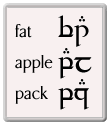Elvish writing - phonetic mode for English
The table below shows how the tehtar can be used to represent the various English vowel sounds.
In the modes for writing English a tehta above the tengwa represents a vowel sound followed by a consonant. If a vowel appears without a following consonant, the tehta is written instead above a carrier letter. A carrier letter is required at the end of a word and for the initial vowels in a sequence of consecutive vowels. There are two carrier letters, one for short vowel sounds  and another for long ones and another for long ones  . .
The A, E, O and U tehta may be doubled to represent long vowel sounds. To write a long vowel when there is no following tengwa use a single tehta over the long carrier. Double tehta are never used over the long carrier. Where the tehtar appears over the short carrier in the 'short' row of the table that tehta may be placed over any other tengwa without changing the vowel sound.
< Prev | Next >
|

![]() and another for long ones
and another for long ones ![]() .
.